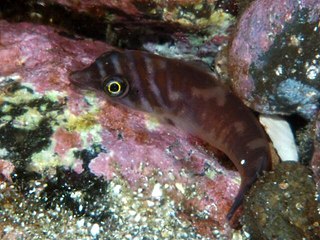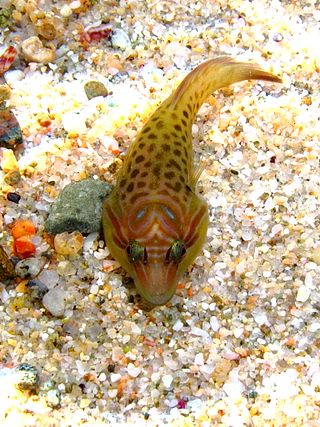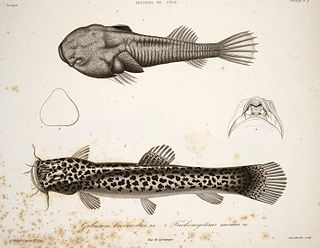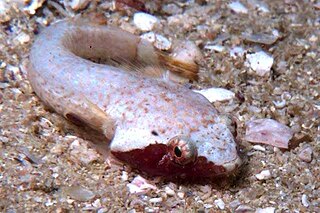
Sarracenia purpurea, the purple pitcher plant, northern pitcher plant, turtle socks, or side-saddle flower, is a carnivorous plant in the family Sarraceniaceae.

Clingfishes are fishes of the family Gobiesocidae, the only family in the order Gobiesociformes. These fairly small to very small fishes are widespread in tropical and temperate regions, mostly near the coast, but a few species in deeper seas or fresh water. Most species shelter in shallow reefs or seagrass beds, clinging to rocks, algae and seagrass leaves with their sucking disc, a structure on their chest.

The shore clingfish is a clingfish of the family Gobiesocidae. It is found in the Mediterranean Sea and adjacent Atlantic Ocean north to Galicia, Spain.

The Mozambique tilapia is an oreochromine cichlid fish native to southeastern Africa. Dull colored, the Mozambique tilapia often lives up to a decade in its native habitats. It is a popular fish for aquaculture. Due to human introductions, it is now found in many tropical and subtropical habitats around the globe, where it can become an invasive species because of its robust nature. These same features make it a good species for aquaculture because it readily adapts to new situations. It is known as black tilapia in Colombia and as blue kurper in South Africa.

Squalius carolitertii, the Northern Iberian chub, is a species of fresh-water fish in the family Cyprinidae. It is found in Portugal and Spain, and known there as the bordallo, escalo or gallego.

The Portuguese blenny, also known as the red blenny, is a species of combtooth blenny found in the eastern Atlantic ocean off western Europe and Macaronesia.
Paraclinus fasciatus, the banded blenny, is a species of labrisomid blenny native to the Atlantic Ocean including the Gulf of Mexico and the Caribbean Sea from southern Florida to Venezuela. The banded blenny is a marine organism, meaning it lives in an aquatic environment. This species lives in the vicinity of coral reefs preferring sea grass beds in shallow waters down to 2 metres (6.6 ft). Although they are typically located in shallow waters, their colors camouflage them exceptionally well, leading to them rarely being seen or recognized. They have also been found within floating algae.

Sicyases sanguineus is a species of amphibious marine clingfish in the family Gobiesocidae. It lives in the Southeast Pacific along the entire coast of Chile and southern Peru.

The black-faced blenny is a small benthic fish from the family Tripterygiidae (triplefin-blennies). It occurs at depths of 3 to 40 metres and lives on the substrate under large rocks, cliffs or other overhangs.
Derilissus is a genus of clingfishes belonging to the family Gobiesocinae found in the western Atlantic Ocean. This family of fish is identified by their appearance as small fish with sucking discs which allow them to attach themselves to various surfaces. Derilissus differs from other genera due to its attached gill membranes.

The blunt-snouted clingfish is a species of clingfish found along the western Mediterranean Sea coasts from Spain to Italy. This species grows to a length of 5 centimetres (2.0 in) TL. The blunt-nosed clingfish is a little known species of shallow water along the littoral of the northern Mediterranean from Alicante to Sicily. Its range was formerly thought to extend to Israel and Syria in the east; however this was actually several closely related cryptic species. It can survive out of the water and occurs only among intertidal pebbles and sand.

Gouania is a genus of clingfishes endemic to the Mediterranean Sea that contains at least 5 cryptobenthic species. The members of this genus are the only vertebrates to inhabit European intertidal gravel beaches and they have developed many adaptations to survive in this extremely harsh environment. They are a type of Clingfish meaning they form part of the Gobiesocidae family. All species of clingfish have a thoracic adhesive disc that allows them to hold on to both smooth and rough surfaces alike. This adaptation enables Gouania to survive the harsh conditions of gravel beaches, they are amongst the only fish taxa adapted to this habitat.

Lepadogaster is a genus of clingfishes native to the eastern Atlantic Ocean extending into the Mediterranean Sea. Lepadogaster belongs to class Actinopterygii. This means that they share many of the same characteristics as eels, ray-finned fish, and sea horses to name a few. The main characteristic of all of them though is having fin rays. These fin rays are made of webbed skin and are attached to portions of the body that connect fins to the bones. Lepadogaster species have a distinct difference in the formation of their dorsal and anal fins. While most other ray-finned fish spines, branched fin-rays, and middle radials, Lepadogaster species do not have these. Instead, they have cartilage in place of the mentioned features. These clingfish are mainly found near the rocky coasts and inside intertidal zones. Lepadogaster is known mostly as a clingfish, meaning that it spends most of its time attached to the surface of rocks.

Lepadogaster candolii, common name Connemarra clingfish, is a species of fish in the genus Lepadogaster. It occurs in the Eastern Atlantic from the British Isles south to Madeira and the Canary Islands and into the western Mediterranean and the Black Sea. The specific name candolii honours the Swiss botanist Augustin Pyramus de Candolle (1778-1841) and has various spellings: candolii, candolei, candollei, and decandollii, but only the first one is correct. Some workers have found that L. candolii is not closely related to the other two species in the genus Lepadogaster and have proposed the placing of this species in the revived monotypic genus Mirbelia Canestrini, 1864, at least until more definitive taxonomic studies can be undertaken.

Diplecogaster bimaculata, the two-spotted clingfish, is a species of fish in the family Gobiesocidae found in Black Sea, Mediterranean Sea and Atlantic Ocean where it is found on rocks and among seagrass or shell beds.
Diplecogaster tonstricula, commonly known as the Eastern Atlantic cleaner clingfish, is a species of clingfish from the family Gobiesocidae, which is found in the tropical eastern North Atlantic Ocean. It has been observed cleaning larger species of fish.

Lepadichthys frenatus, the bridled clingfish, is a species of clingfish from the family Gobiesocidae. It is found on shallow reefs in the western Pacific Ocean.

Opeatogenys gracilis is a species of clingfish from the family Gobiesocidae which is found in the Mediterranean Sea and in the eastern Atlantic Ocean. Suggested common names for this species are the pygmy clingfish and the seagrass clingfish.

Sicyases brevirostris is a species of clingfish from the family Gobiesocidae. It is endemic to the rocky intertidal zones of the Juan Fernández Islands, Chile. It was described in 1848 as Gobiesox brevirostris by Alphone Guichenot. Fishbase treats Sicyases hildebrandi as synonymous with S. brevirostris although some authorities still treat S. hildebrandi as a valid species.

Apletodon pellegrini, the chubby clingfish, is a species of clingfish of the family Gobiesocidae. The species is found in the Eastern Atlantic, from Madeira, Cape Verde, Canary Islands, Annobon Islands, mainland shore from Cape Blanco south to Port Alfred, South Africa.

















